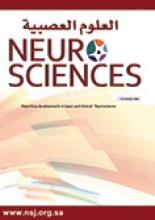Abstract
OBJECTIVE: The present work was planned to report the incidence of calcification and ossification of an isolated cranial dural fold. The form, degree of severity and range of extension of such changes will be described. Involvement of the neighboring brain tissue and blood vessels, whether meningeal or cerebral, will also be determined. The results of this study might highlight the occasional incidence of intracranial calcification and ossification in images of the head and their interpretation, by radiologists and neurologists, to be of dural or vascular origin.
METHODS: Two human formalin-fixed cadavers, one middle-aged female another older male, were investigated at the Anatomy Laboratory, College of Medicine, King Faisal University, Dammam, Kingdom of Saudi Arabia during the period from 2000 to 2003. In each cadaver, the skullcap was removed and the convexity of the cranial dura mater, as well as the individual dural folds, were carefully examined for any calcification or ossification. The meningeal and cerebral blood vessels together with the underlying brain were grossly inspected for such structural changes. Calcified or ossified tissues, when identified, were subjected to histological examination to confirm their construction.
RESULTS: The female cadaver showed a calcified parietal emissary vein piercing the skullcap and projecting into the scalp. The latter looked paler and deficient in hair on its right side. The base of the stump was surrounded by a granular patch of calcification. The upper convex border of the falx cerebri was hardened and it presented granules, plaques and a cauliflower mass, which all proved to be osseous in structure. The meningeal and right cerebral vessels were mottled with calcium granules. The underlying temporal and parietal lobes of the right cerebral hemisphere were degenerated. The male cadaver also revealed a calcified upper border of the falx cerebri and superior sagittal sinus. Osseous granules and plaques, similar to those of the first specimen, were also identified but without gross changes in the underlying brain.
CONCLUSION: Calcification or ossification of an isolated site of the cranial dura mater and the intracranial blood vessels might occur. These changes should be kept in mind while interpreting images of the skull and brain. Clinical assessment and laboratory investigations are required to determine whether these changes are idiopathic, traumatic, or as a manifestation of a generalized disease such as hyperparathyroidism, vitamin D-intoxication, or chronic renal failure.
- Copyright: © Neurosciences
Neurosciences is an Open Access journal and articles published are distributed under the terms of the Creative Commons Attribution-NonCommercial License (CC BY-NC). Readers may copy, distribute, and display the work for non-commercial purposes with the proper citation of the original work.






